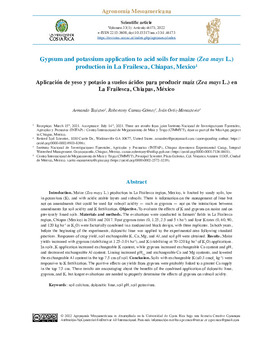Mostrar el registro sencillo del ítem
Gypsum and potassium application to acid soils for maize (Zea mays L.) production in La Frailesca, Chiapas, Mexico
| Creador: | Tasistro, A. |
| Creador: | Camas Gomez, R. |
| Creador: | Ortiz-Monasterio, I. |
| Año: | 2022 |
| URI: | https://hdl.handle.net/10883/22033 |
| Lenguaje: | English |
| Editor: | Universidad de Costa Rica |
| Copyright: | CIMMYT manages Intellectual Assets as International Public Goods. The user is free to download, print, store and share this work. In case you want to translate or create any other derivative work and share or distribute such translation/derivative work, please contact CIMMYT-Knowledge-Center@cgiar.org indicating the work you want to use and the kind of use you intend; CIMMYT will contact you with the suitable license for that purpose |
| Título Alternativo: | Aplicación de yeso y potasio a suelos ácidos para producir maíz (Zea mays L.) en La Frailesca, Chiapas, México |
| Tipo: | Article |
| País de enfoque: | Mexico |
| Lugar de publicación: | San Jose (Costa Rica) |
| Número: | 1 |
| Volumen: | 33 |
| DOI: | 10.15517/am.v33i1.46173 |
| Palabras Claves: | Soil Calcium |
| Palabras Claves: | Soil Potassium |
| Descripción: | Introduction. Maize (Zea mays L.) production in La Frailesca region, Mexico, is limited by sandy soils, low in potassium (K), and with acidic arable layers and subsoils. There is information on the management of lime but not on amendments that could be used for subsoil acidity — such as gypsum — nor on the interactions between amendments for soil acidity and K fertilization. Objective. To evaluate the effects of K and gypsum on maize and on previously limed soils. Materials and methods. The evaluations were conducted in farmers’ fields in La Frailesca region, Chiapas (Mexico) in 2016 and 2017. Four gypsum rates (0, 1.25, 2.5 and 5 t ha-1) and four K rates (0, 60, 90, and 120 kg ha-1 as K2O) were factorially combined in a randomized block design, with three replicates. In both years, before the beginning of the experiments, dolomitic lime was applied to the experimental area following standard practices. Responses of crop yield, soil exchangeable K, Ca, Mg, and Al, and soil pH were obtained. Results. Maize yields increased with gypsum (stabilizing at 1.25-3.0 t ha-1), and K (stabilizing at 70-120 kg ha-1 of K2O) applications. In soils, K application increased exchangeable K content, while gypsum increased exchangeable Ca content and pH, and decreased exchangeable Al content. Liming increased pHCa and exchangeable Ca and Mg contents, and lowered the exchangeable Al content in the top 7.5 cm of soil. Conclusion. Soils with exchangeable K (≤0.3 cmolc kg-1) were responsive to K fertilization. The positive effects on yields from gypsum were probably linked to a greater Ca supply in the top 7.5 cm. These results are encouraging about the benefits of the combined application of dolomitic lime, gypsum, and K, but longer evaluations are needed to properly determine the effects of gypsum on subsoil acidity. |
| Agrovoc: | DOLOMITIC LIME (AMENDMENT) |
| Agrovoc: | SOIL PH |
| Agrovoc: | MAIZE |
| Agrovoc: | POTASSIUM |
| ISSN: | 1021-7444 |
| Revista: | Agronomy Mesoamerican |
| Número de artículo: | 46173 |
Ficheros en el ítem
Este ítem aparece en la(s) siguiente(s) colección(ones)
-
Maize
Maize breeding, phytopathology, entomology, physiology, quality, and biotech

